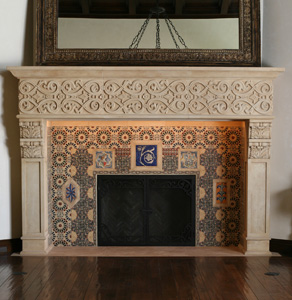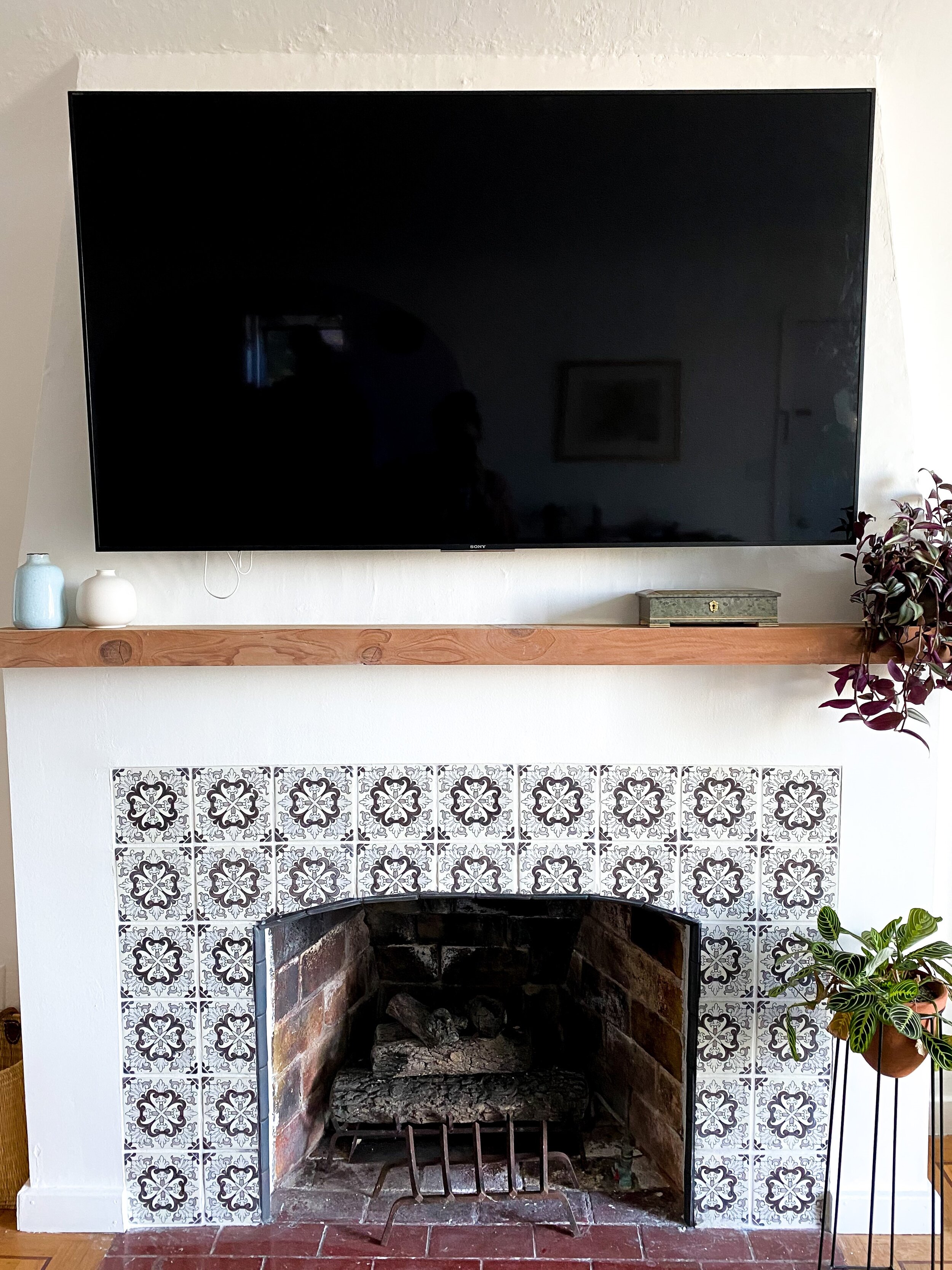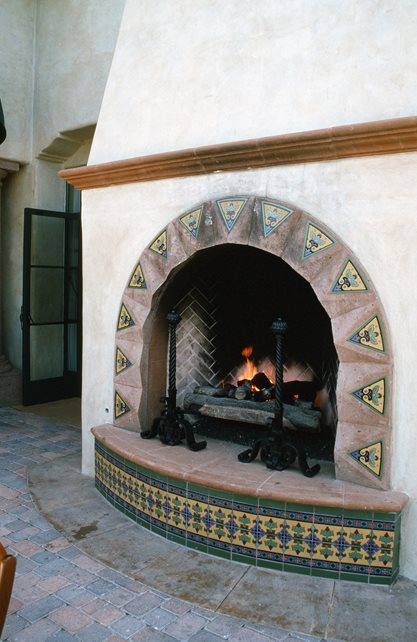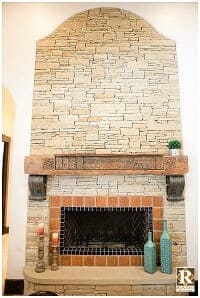I’ve always been drawn to the warmth and character of Spanish tile fireplaces. There’s something about their rich colors and intricate patterns that instantly makes a room feel more inviting. Whether you’re going for a Mediterranean vibe or just want to add some old-world charm to your space, Spanish tiles can transform an ordinary fireplace into a stunning focal point. From traditional hand-painted designs to more modern interpretations, these tiles offer endless possibilities for customization. Here’s what I’ve discovered about incorporating Spanish tiles into fireplace designs.
The History and Appeal of Spanish Tiles
Spanish tiles, or “azulejos,” have been used in architecture for centuries, particularly in Spain and Portugal. I love how they tell a story through their patterns and colors, often reflecting Moorish influences with geometric designs or floral motifs. When used on a fireplace, they create an instant connection to this rich cultural heritage. The tiles’ durability also makes them practical for high-heat areas, which is why they’ve remained popular for fireplace surrounds.
What first attracted me to Spanish tiles was their handmade quality. Unlike mass-produced tiles, many Spanish tiles have slight variations in color and texture that give them authentic character. I remember visiting a historic home where the fireplace tiles had faded unevenly over time, creating a beautiful patina that modern tiles can’t replicate. This imperfect perfection is part of what makes them so special.
Today, you can find Spanish tiles that range from faithful reproductions of antique designs to contemporary interpretations. Some feature traditional cobalt blue and white patterns, while others use bolder colors like terracotta red or sunflower yellow. I’ve seen fireplaces where just a few strategically placed decorative tiles make a big impact, as well as full tile surrounds that create a dramatic statement.
Choosing the Right Tile Pattern
Selecting the perfect tile pattern can feel overwhelming given all the options available. I recommend starting by considering the overall style of your room. For a classic Spanish look, geometric patterns or floral designs work beautifully. In my own home, I chose a repeating quatrefoil pattern in blue and white that complements my traditional decor without being too overwhelming.
Scale is another important factor. Large-format tiles with bold patterns make a strong statement but might dominate a small room. Smaller tiles arranged in intricate patterns can create visual interest without overpowering the space. I once worked with a client who used 1-inch hexagonal tiles to create a mosaic-like effect around their fireplace – the result was stunning yet subtle.
Don’t be afraid to mix patterns either. Many authentic Spanish designs combine different motifs in harmonious ways. I’ve seen fireplaces where a central decorative tile is surrounded by simpler border tiles, creating a focal point while maintaining balance. The key is to choose patterns that share a common color palette or design element to tie everything together.
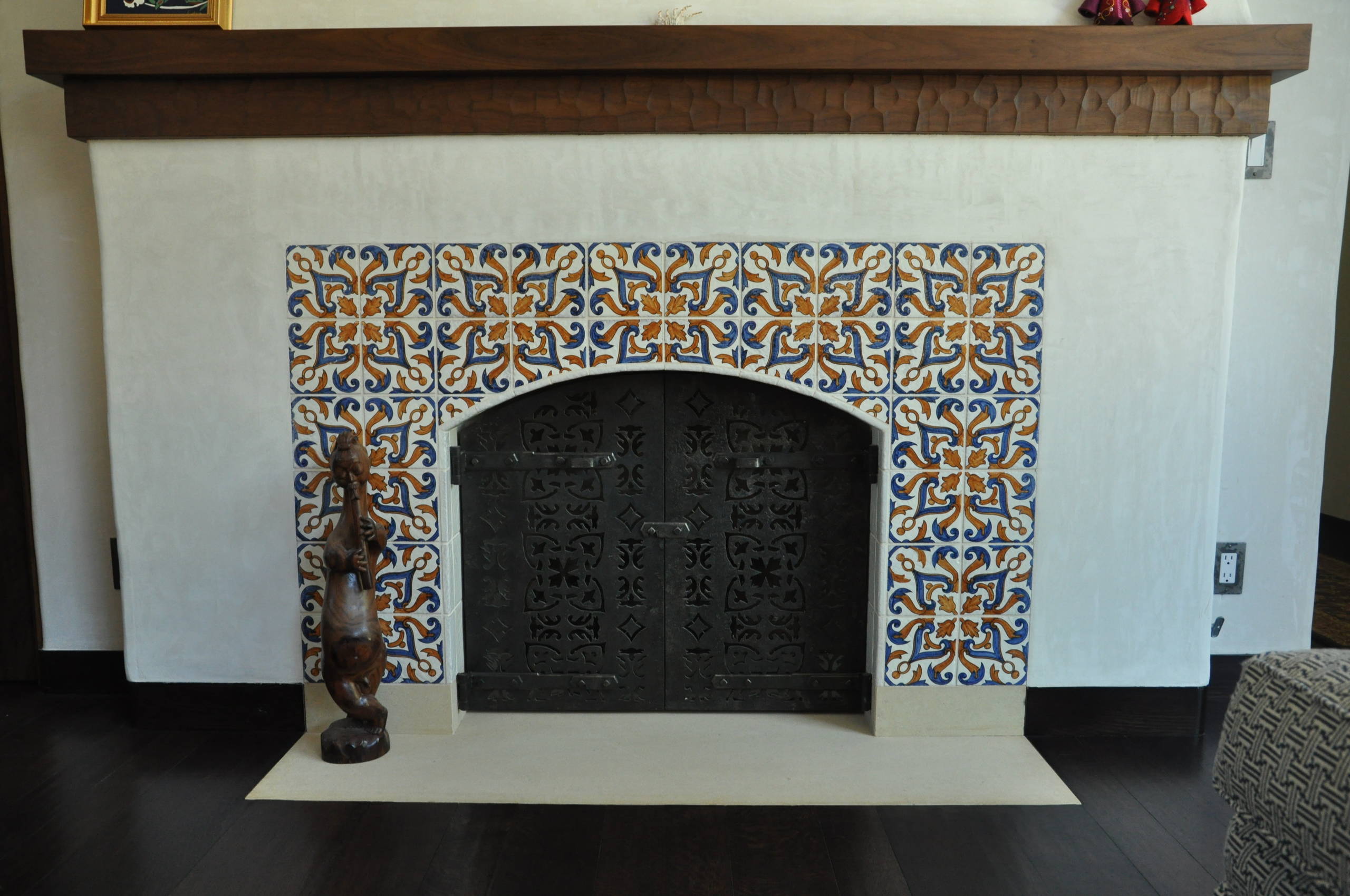
Color Combinations That Work
The color palette you choose can dramatically affect the mood of your fireplace. Traditional Spanish tiles often feature cobalt blue and white, which I find creates a crisp, classic look. In my sunroom, I used these colors for a fresh, airy feel that brightens up the space even on cloudy days. The blue tones pair wonderfully with natural wood and wrought iron accents.
For warmer, earthier spaces, terracotta reds, golden yellows, and deep greens are excellent choices. I helped a friend select tiles in these hues for her rustic living room, and the result was incredibly cozy. The rich colors complement the natural stone of her fireplace and make the whole area feel welcoming. These warmer tones work particularly well in rooms with southwestern or Mediterranean decor.
If you prefer something more contemporary, consider muted versions of traditional colors or monochromatic schemes. I’ve seen modern interpretations using gray-blue tiles or soft sage green that maintain the Spanish aesthetic while feeling current. For a truly unique look, some artisans create custom color combinations – I once saw a fireplace with lavender and cream tiles that was absolutely breathtaking.
Installation Considerations
Installing Spanish tiles requires some special considerations compared to standard tile. First, because many Spanish tiles are handcrafted, there can be slight size variations between pieces. I learned this the hard way when my first attempt at a DIY installation resulted in uneven grout lines. Now I always recommend dry-laying the tiles first to identify any adjustments needed before applying adhesive.
The surface preparation is crucial too. Fireplace surrounds need a stable, heat-resistant backer board as a base. In my kitchen remodel, I used cement backer board cut to size before tiling, which provided a solid foundation. It’s also important to use the right type of thin-set mortar – one rated for high temperatures to prevent cracking over time.
Grout selection can make or break the final look. For authentic Spanish style, I often use sanded grout in a color that complements but doesn’t compete with the tiles. A gray or beige grout tends to work well with most traditional color schemes. In my bathroom, I matched the grout to the lightest color in the tiles, which helped create a cohesive appearance while still allowing the patterns to stand out.
Maintaining Your Tiled Fireplace
One concern many people have is how to care for tiled fireplace surrounds. I’ve found that Spanish tiles are surprisingly easy to maintain. For regular cleaning, a soft cloth or duster removes most surface dust. When deeper cleaning is needed, I use a mild soap solution and avoid harsh chemicals that could damage the glaze.
The grout may require occasional attention, especially in high-use areas. I apply a grout sealer annually to prevent staining and make cleaning easier. In my own home, I chose a slightly darker grout color than the tiles to minimize the appearance of dirt over time. For stubborn stains, a paste of baking soda and water gently lifts discoloration without damaging the tiles.
Heat resistance is another advantage of Spanish tiles. The ceramic material stands up well to fireplace temperatures, though I always recommend using a screen to protect the tiles from direct flames. After five years, my tiled surround still looks as good as new, with no cracking or discoloration from heat exposure. Properly cared for, these tiles can last for generations.
Incorporating Spanish Tiles in Modern Homes
You don’t need a Spanish-style home to enjoy these beautiful tiles. I’ve seen them work wonderfully in contemporary spaces when used thoughtfully. One approach is to create a tile “frame” around the fireplace opening while keeping the rest of the surround simple. In my modern living room, I used just a border of patterned tiles with plain white subway tiles elsewhere for a subtle nod to the Spanish tradition.
Another way to blend old and new is through color choices. Selecting Spanish tiles in more muted, modern colorways can bridge the gap between traditional and contemporary. I recently worked on a project where we used gray-scale versions of traditional patterns – the result was clearly Spanish-inspired but felt completely current.
For those who want just a touch of this style, consider using decorative tiles as accents rather than covering the entire surround. I’ve placed single decorative tiles at each corner of a fireplace for a hint of pattern without overwhelming the space. This approach lets you enjoy the beauty of Spanish tiles while keeping your overall decor scheme intact.
Are Spanish tiles suitable for wood-burning fireplaces?
Yes, Spanish tiles work well with wood-burning fireplaces as they’re made from heat-resistant ceramic materials. However, they should only be used on the surround, not inside the firebox where temperatures are highest. I always recommend maintaining proper clearance between the fire and tiles, typically at least 6 inches. Using a fireplace screen provides additional protection from direct flames and sparks that could damage the tile surface over time.
The glaze on Spanish tiles helps protect them from heat and soot, but regular cleaning is still important. After years of use with my wood-burning fireplace, I’ve found that wiping down the tiles periodically prevents soot buildup. The tiles have maintained their color and finish beautifully, proving their durability in real-world conditions.
How do Spanish tiles compare in cost to other fireplace surround options?
Spanish tiles can range from moderately priced to quite expensive depending on quality and whether they’re handmade. Generally, they cost more than basic ceramic tiles but less than premium natural stone options like marble. I’ve found that authentic handmade Spanish tiles typically run 10−30 per square foot, while factory-made versions can be as low as 5−15 per square foot.
While the initial investment might be higher than some alternatives, I consider Spanish tiles a worthwhile splurge. Their durability means they’ll last for decades, and their timeless appeal ensures they won’t look dated. In my experience, the beauty and character they add to a room more than justify the cost. Many homeowners find that using tiles just around the fireplace opening (rather than covering the entire wall) makes the project more budget-friendly.
Can I install Spanish tiles over my existing fireplace surround?
In many cases, yes – I’ve successfully installed Spanish tiles over existing brick and stone fireplace surrounds. The key is proper surface preparation. The existing surface must be clean, stable, and free of loose material. I typically rough up smooth surfaces with sandpaper and apply a bonding primer to ensure good adhesion. For painted surfaces, it’s crucial to remove any flaking paint first.
However, there are situations where removal of the old surround is better. If the existing surface is uneven or damaged, starting fresh might be wiser. I once helped a friend remove crumbling mortar from her brick fireplace before tiling, which created a much better end result. Always consult with a tile professional if you’re unsure about your specific situation. Proper installation ensures your beautiful new tiles will stay in place for years to come.
Do Spanish tiles work with electric fireplaces?
Absolutely! Spanish tiles can create a stunning frame for electric fireplaces. In fact, they’re often easier to install with electric units since you don’t have to worry about heat resistance as much. I recently designed a feature wall with an electric fireplace flanked by Spanish tiles – the combination of modern convenience and traditional charm worked perfectly.
One advantage with electric fireplaces is more flexibility in tile placement. Since there’s no actual heat output, you can tile right up to the opening without concern. I’ve even seen creative installations where tiles continue inside the fireplace cavity for a cohesive look. This opens up possibilities that wouldn’t be practical with wood-burning units. The tiles help elevate the electric fireplace from utilitarian to a true design feature.
How do I choose between matte and glossy finish tiles?
The finish you choose affects both the appearance and maintenance of your fireplace. Glossy tiles reflect more light and make colors appear more vibrant, which I’ve found works well in darker rooms. However, they do show fingerprints and dust more easily. In my kitchen, I went with glossy tiles because I wanted the colors to really pop, and I don’t mind wiping them down frequently.
Matte finishes offer a more subdued, traditional look that hides minor imperfections well. They’re great for creating an authentic aged appearance. I used matte tiles in my living room fireplace because I preferred the softer, more rustic effect. They’re also slightly easier to maintain as they don’t show smudges as readily. Consider your lighting conditions and how much maintenance you’re willing to do when making this choice.
Where can I find authentic Spanish tiles?
Authentic Spanish tiles can be sourced from specialty tile shops or directly from manufacturers in Spain. I’ve had good luck with online retailers that specialize in imported tiles – they often provide samples so you can see the colors and quality firsthand. Some companies even offer historic reproduction tiles with traditional patterns and techniques.
For local shopping, check with tile stores that carry international products. I found a wonderful selection at a specialty tile showroom in my city that works directly with Spanish artisans. If you’re visiting Spain (or know someone who is), buying tiles there can be a great option – just factor in shipping costs. Wherever you purchase, ask about the tile’s origin and manufacturing process to ensure you’re getting genuine Spanish quality.
Stunning Fireplace Tile Ideas to Inspire Your Space
Mexican tiled fireplace Fireplace tile surround, Mexican tile
Spanish Tiles Create Border for Fireplace
Mediterranean Fireplace – Morongo Valley, CA – Photo Gallery
How to Create a Rustic Style Fireplace for Spanish Home Decor
Pictures and ideas for Mexican Style Fireplaces
Related Posts:


